
BY TORI LANG
As a long standing motorcyclist, I am well aware of the physical and mental demands of riding. It was my keen interest in both yoga and motorcycling that led me to qualify as a yoga teacher and establish ‘Yoga for Bikers’.
I went to events like Horizons Unlimited, and saw that people would spend hours, even months, preparing their kit, bike, route, visas etc but very little attention to the one thing that really made the most difference as to how much they enjoyed their ride – themselves.
I had learned things from yoga that were invaluable in helping to cope with the demands of riding and travelling and was keen to share. From the start, the yoga sessions I led were popular and well attended – it seemed I’d struck a chord!
How can yoga help?
There are so many ways – where to start? One of the top reasons is getting you as strong, flexible and healthy as possible before you embark on the journey. As a group, motorcyclists tend to be a battered bunch. If you have an accident in a remote area, the health services sometimes aren’t there to patch you back up, so there are often injuries that have not healed well. Motorcyclists also have more damage generally to the body (from various accidents over the years) than Joe Public. All that sitting is not great and general tightness and back issues are common (due mainly to weak cores, tight hamstrings, and tight hip flexors). Yoga is a great way to get you ‘ride-ready’, and keep you going on your big adventure.
Travelling though, is as much mental as physical, and another yoga benefit is in keeping our cool when faced with challenges on the road. It may be something as simple as feeling a bit ‘unsettled’ from changing time zones or cultures, or the frustrations of border crossings, visas and red tape. Coping with stress, anxiety and depression are among the top reasons many people begin yoga, and motorcyclists benefit here too.
Yoga improves quality of sleep, and quite simply, the world is a better place when we’re better rested, so we’re much more able to enjoy the trip and view challenges more positively. We’re more relaxed, happier, more focused and alert, and likely a better riding companion too!
Another benefit that surprises novices is that there are yoga practices that can also help to moderate your body temperature – did you know that yoga can cool you down or warm you up?
Breathing is a big part of yoga, and something that can keep you safe on the road. Learning to breathe through tricky situations, that truck cornering on your side of the road, the herd of livestock filling the road, this tricky terrain, breathing can help you keep your balance and focus and ride more safely through these challenges.
‘Touch wood’ but if disaster does strike, yoga can also be helpful with pain management and then speed and thoroughness of recovery from injury.
Feeling stronger, better balanced, more aware of posture and riding style also means there are less aches and pains at the end of the day, less tension gathering to have to undo later on. All of these things add up; better attention when riding, less risk of an accident or injury, covering greater distances more comfortably. Being physically in the best shape you can be will make the ride a lot more enjoyable.
So where do I sign up?! I hear you ask…
I recommend – start early, well before your trip – to get your body and mind in top shape before you start. Yoga is not a quick fix, and if you’re already carrying injuries, or issues then a quick rule of thumb is one month of regular yoga practice to undo every year your body has been that way. So include yoga sooner rather than later as part of your preparations. This also enables you to learn a wider repertoire of yoga practices and discover the ones most helpful for you.
Find a professional, certified yoga instructor near you. Like dance, there are many different forms of yoga, so find a class and teacher that suit your needs. The key things are: yoga should not be painful – always work within your pain free range of movement and yoga is not competitive – it is a personal, internal practice. Learn from a teacher not a DVD/book though – teachers offer modifications and guide you in working with injuries.
I focus on the common tight spots and issues that riders get, but many of these overlap with office workers, runners and cyclists, so yoga classes for these groups will also be beneficial (and you may well be working an office job whilst saving for your trip).
I include modifications to show people how to practice whilst ‘on the road’. You can manage a lot with a camping mat, sleeping bag, and tent roll, so get creative with the equipment you have to hand. There are many practices that can be done lying down in limited space, so you can even practice yoga from the comfort of your tent. Some yoga is great during the day e.g. whilst at a rest stop, and others are best at the beginning or end of the day’s riding.
Common tight spots or ‘issue areas’ for motorcyclists.
• Tight/injured ankles
• Tight hamstrings
• Tight hip flexors
• Lower back complaints
• Weak core
• Shoulder injuries / tightness across the chest and shoulders
• Neck injuries / stiffness
• Wrist injuries
• Multiple injuries issues
• Pins, plates, surgeries, leaving some restriction of movement
Top 5 poses for motorcyclists
Remember – stay within your pain free range of movement.
1) Reclining Cobbler:
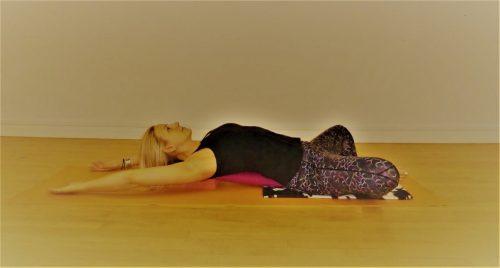
This is a fantastic pose for the end of a long ride, to undo tension that’s accumulated whilst riding. You need a sausage shaped roll behind you (I’m using a rolled mat, with one end on a block. You could use your camping mat with one end resting on your boots). The soles of the feet are together, the hips are on the floor, the arms are as far overhead as shoulder injuries permit (you can take the arms wider if there are injuries there).
This pose is pretty much the exact opposite of the riding position. The weight of the head is supported so the neck can relax. The shoulders are dropping back either side of the roll, opening across the front of the chest. With the arms overhead, there’s a stretch through the inner upper arms, armpit area and side chest. There’s a gentle back bend, rather than a slouchy forward bend. There’s lots of length and space in the belly (a great pose for menstrual or other abdominal cramps/indigestion) and the hips are opening out.
If you do nothing else, do this at the end of a ride to relax and unwind.
2) Warrior One
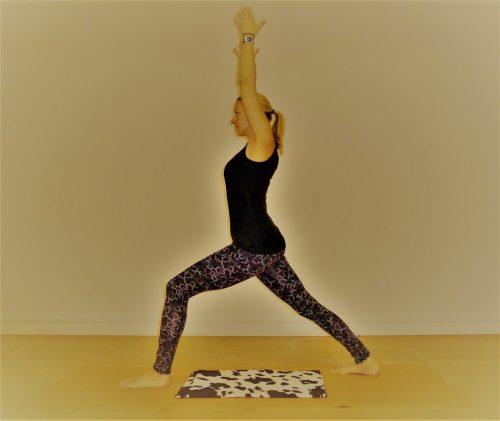
This is a great pose to practice during your day’s riding – it’s my service stop pose. Both feet and the hips are pointing forwards, and the feet are hip width apart to help with balance. The back heel is grounded (you may need to shorten the length of the pose if you have tight calves). The pubis lifts at the front of the pelvis to keep the lower back long.
This pose stretches the calf and hamstrings on the back leg, and as you lift the pubis, you’ll feel a stretch in the hip flexor of the back leg too (the front of the hip). Reaching up through the arms also stretches the side chest and side waist, which helps us breath more fully.
3) Snake and Locust
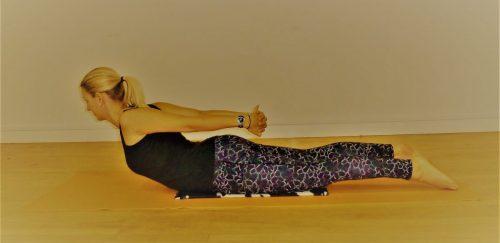
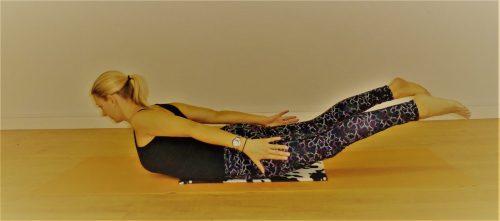
Both of these poses are great back strengtheners and posture improvers. In Snake (top) just the upper body lifts, in Locust (bottom) the legs lift too. Inhale to lift into the pose and exhale back down (x 6). The heads of the shoulders draw back, the fingers are interlaced (in snake) or palms face inwards (locust) reaching back towards the feet, elbows straight. In locust, the legs are straight and lifting from the inner thighs.
These poses help to correct rounded shoulders and open the front of the chest, whilst building strength in the back.
4) Cow faced pose (variations)
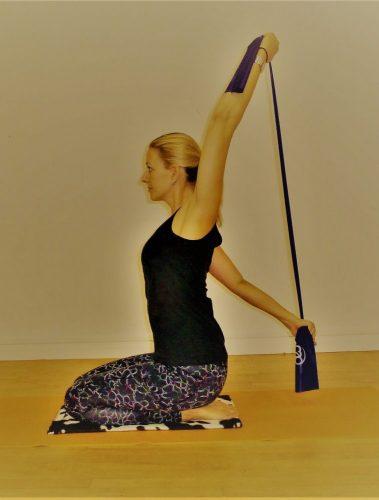
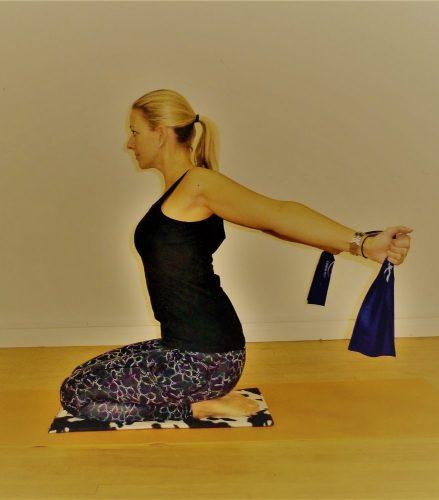
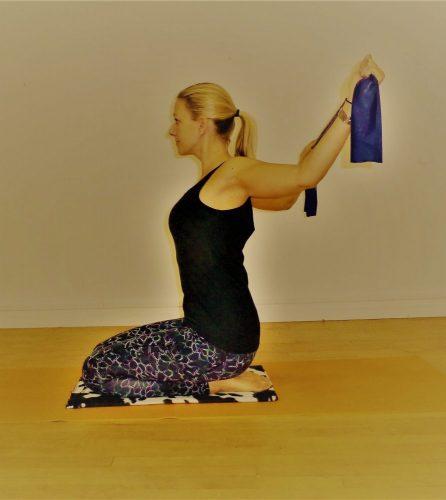
These are amazing shoulder stretches.
I’m using an exercise elastic (dynaband/theraband) but on the road, try a luggage elastic, inner tube, or leggings, although since they’re small I often travel with a band. Start with the hands shoulder width apart (hands wider to make it easier, or closer to make it stronger). Take one arm up and back, and the other arm down and back. Let the tension in the band draw your hands towards each other. If you have wrist injuries, keep the hand in line with the forearm. Don’t over-arch the back.
The second variation takes the arms behind at shoulder height, letting the tension in the band stretch across the front of the chest. After a tough day riding, the front of the chest can be really tight and rounds the body forwards – this pose opens that out.
The third variation is similar, but with the arms bent. Move your arms slowly up and down to stretch through different parts of the inner upper arm, shoulder and chest.
5) Revolved cat
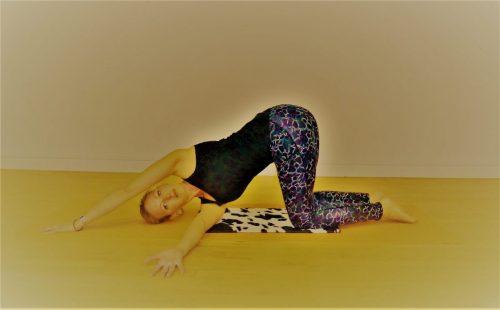
This pose is great for releasing tension from the upper back, keeping the spine mobile, benefits the immune system and helps clear congestion from the chest.
Starting on all fours, reach one hand at full reach along the ground. Take the other arm and reach under and through. Work on twisting from your core towards the ceiling. Make sure your neck feels comfortable and in line with the spine. Bring your awareness to breathing into the space between your shoulder blades and spiralling the spine from the hips to the head. Hold for 6 breaths, switch sides.

5 comments
Totally Agree! Riding a motorcycle and ashtanga yoga practice became part of my life almost simultaneously. The connections between the two are plenty. Personally I find both are routed in same mindset, a beautiful combination of focus, stillness, awareness and being here now. And riding the bike through heavy traffic always seems to be easier after practice.
Fantastic! Finally we’re talking about all factors of riding not just bike preparation. I’m now sixty and want to continue riding all long as possible. I am finding I tirer sooner these days and experience more joint and muscle aches. I’m hoping your simple but great yoga positions will help. Keep them coming 👍🏍
I am an Avid Biker as well as a Reg. Yoga Instructor. I also work in a Veterans Medical office setting and have found many Veterans to be Bikers ! My Business is called Iron Horse Yoga. Do I need to ask permission or pay to print off this fantastic Article ? ! I would definitely understand and have no problem with doing so ! Please let me know as I could not get a good copy to print off ! Thank You for This ! Deb
Thank you Deb! We love it that you found the article useful. Do go ahead and print it, just please credit Tori Lang for the piece!:)
All of this is true, thank you Tori.
I’m a former MSF rider coach and a certified yoga teacher. Last fall, along with Brina, the activity coordinator of Superstition Harley Davidson in Apache Junction, we started a yoga for bikers session at the dealership. The feedback has been positive and after a summer hiatus, we are now planning for a ride to a park or wilderness area for yoga once a month. In order to contextualize this experience for many riders, I’ve used language from both disciplines to speak about yoga. FOr example, in motorcycling we find the friction zone when learning how to ride and we can do that here too. Or I will rename poses, for example rather than chair or awkward pose, I’ll say “sitting at the stoplight pose.” It seems to make all of this more relevant.
In addition, when it comes to work on concentration, there is nothing more challenging and sublime at the same moment than hearing the bikes roar at the dealership, just below us on the outside deck, where we practice. If I’m giving instruction in that moment, I just have to smile and wait until the bike leaves. In the meantime, we’ll just stare at the mountain in the distance in a solid tadasana (mountain pose)